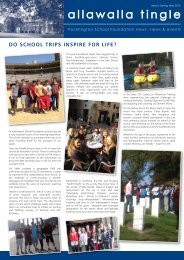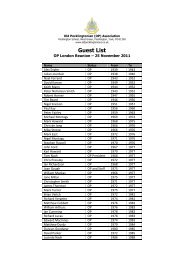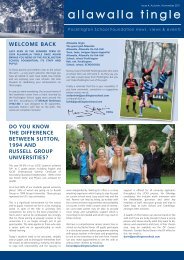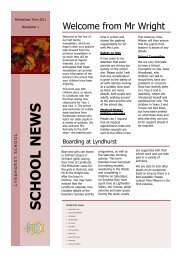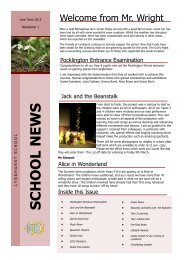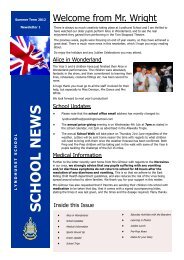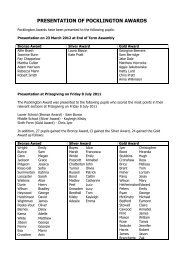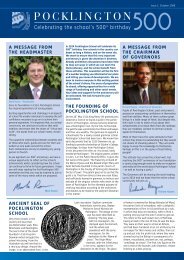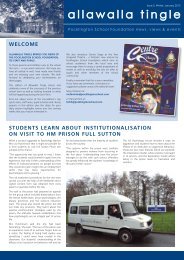Pock 500 ed.4 - outer low - Pocklington School
Pock 500 ed.4 - outer low - Pocklington School
Pock 500 ed.4 - outer low - Pocklington School
You also want an ePaper? Increase the reach of your titles
YUMPU automatically turns print PDFs into web optimized ePapers that Google loves.
PATRONS<br />
We are delighted to announce that a<br />
number of friends of <strong>Pock</strong>lington <strong>School</strong><br />
Foundation have kindly accepted the<br />
Headmaster’s invitation to become a<br />
patron.<br />
The Honourable Mrs Susan Cunliffe-Lister,<br />
Lord Lieutenant of East Yorkshire, was the<br />
guest of honour at our prizegiving in 2009. She<br />
was appointed High Sheriff in East Yorkshire in<br />
2001, the first woman to hold this office since<br />
its origin in Anglo Saxon times.<br />
Professor Christopher Dobson is professor of<br />
Chemical and Structural Biology at the University<br />
of Cambridge, and has been Master of St John’s<br />
College since 2007. The school’s foundation<br />
charter is held in the college library and is a<br />
testament to the long and active relationship<br />
between school and college.<br />
Mr Brian Fenwick-Smith is an OP,<br />
entrepreneur and school benefactor. He has<br />
assisted the school in ‘masterplanning’ recent<br />
developments to the campus and his generosity<br />
al<strong>low</strong>ed the school to build a very fine and much<br />
admired senior boys’ boarding house.<br />
Fenwick-Smith House was opened in 2007.<br />
The Right Honourable the Earl of Halifax is<br />
a Governor of <strong>Pock</strong>lington <strong>School</strong> Foundation<br />
and a Deputy Lord Lieutenant for East Yorkshire.<br />
Lord Halifax is also High Steward of York Minster<br />
and a J.P. Lord Halifax has been a close supporter<br />
of the school over many years.<br />
The Very Reverend Keith Jones, Dean of York.<br />
In the early years of the school’s foundation the<br />
Dean was one of the few individuals who could<br />
discipline the Headmaster of <strong>Pock</strong>lington <strong>School</strong>!<br />
In 2007 the school choir was invited by the<br />
Minster to take part in its Wilberforce<br />
celebrations and in the time ahead we<br />
hope to strengthen the friendship.<br />
We thank each of them for their support and<br />
look forward to their involvement in our<br />
celebrations.<br />
Andrew Dawes<br />
MAN. To show a dove above a man would be a<br />
more satisfying rebus.<br />
In a letter to the school in 1950, the Chester<br />
Herald reported that “the original Grant of Arms<br />
to John Dowman has been traced… The arms<br />
are blazoned as fol<strong>low</strong>s: Azure a fesse dancette<br />
between eight garbs or, banded gules, on the<br />
fesse three doves of the field beaked and<br />
membered.” That is a blue field with a gold<br />
zigzag between eight gold wheat sheaves with<br />
red bands round them. On the zigzag three<br />
doves in their natural colours, with beaks and<br />
feet.<br />
THE FOUNDER’S COAT OF ARMS<br />
The recent discovery of the school’s Foundation<br />
Document of 1514 in St. John’s College Library<br />
was an event of great significance for us. A<br />
report of the document was given in the last<br />
issue of ‘<strong>Pock</strong>lington <strong>500</strong>’. The majority of the<br />
text is in Latin, and this has been painstakingly<br />
translated by two OPs, David Stather and Keith<br />
Walls.<br />
One intriguing aspect of the document is the<br />
carefully ruled off blank square near the end.<br />
Into this space at some point a coat of arms<br />
has been drawn. The drawing is amateurish and<br />
hurried – so very different from the beautiful<br />
and assured script used throughout. In one<br />
significant way the arms differ from the version<br />
the school uses. But first it might be useful to<br />
look at the arms we use today.<br />
In 2007 the Somerset Herald wrote to the school<br />
confirming the Dowman arms as ‘azure, a fess<br />
dancetty between eight garbs or banded gules’.<br />
This means a blue background to the shield with<br />
gold zigzag across the middle and eight wheat<br />
sheaves, four above the zigzag, four be<strong>low</strong>, each<br />
of them with a red band around it.<br />
However, the arms in the Foundation Document<br />
show three birds on the fess. These birds are<br />
doves, and in the days before regularised<br />
spelling, the family used a number of variants<br />
for their name: Dowman, Dolman, Dowlman<br />
and Doveman. It could be that this was the<br />
version of the family arms created by our<br />
Founder as his own.<br />
Did he himself draw this sketch? If the coat of<br />
arms had been granted to his father, or was<br />
even earlier, was John Dowman seeking to<br />
produce a difference in the customary way? The<br />
space in the document certainly looks as though<br />
it has been left for a coat of arms, but it has not<br />
been professionally, or even competently, drawn.<br />
The four garbs be<strong>low</strong> the awkwardly drawn fess<br />
are not spaced evenly as they are in all other<br />
versions.<br />
One intriguing detail is the smiley face added to<br />
the left-hand side garb. Could this be Dowman<br />
trying to create a rebus, that is a pictorial play on<br />
his name - Dove - man? An account of the<br />
school written in the nineteenth century says<br />
that in the early 1800s there was a rebus on one<br />
of the beams - be<strong>low</strong> the three doves the letters<br />
Almost the same information has come from an<br />
early document seen by the school: Azure on a<br />
fesse dancette between eight garbs or three<br />
birds close of the field beaked and membered<br />
gules. Crest on a bezant a bird as in the arms.<br />
In addition, therefore, we learn that the birds’<br />
feet and beaks were red, and that there was<br />
also a crest - a bird on a gold coin. The latter is<br />
certainly different from the crest shown on most<br />
other examples of the family’s coat of arms.<br />
In an attempt to sort out the school’s use of<br />
the Dolman heraldry, Alan Heaven was asked<br />
to examine the subject and produce a report.<br />
He drew these three conclusions:<br />
1. The arms which the school presently uses,<br />
in various corrupted forms, are those of<br />
the Dolman family.<br />
2. The arms are not those of the founder,<br />
John Dowman.<br />
3. The school has been using arms to which<br />
it has no right and has no grant of arms of<br />
its own.<br />
He added that “The closing line must be that the<br />
school should petition for new arms”. The <strong>500</strong>th<br />
anniversary would seem to be a good time to do<br />
so. There is, however, a cost to such an initiative,<br />
and we have been advised it would be in the<br />
region of £5,000. We will add this suggestion to<br />
our wish list, a list we are soon going to need to<br />
put in order of priority.<br />
Copies of the full text of Alan Heaven’s<br />
paper, ‘A Survey of the Heraldry of<br />
<strong>Pock</strong>lington <strong>School</strong>’, can be obtained<br />
on request.



